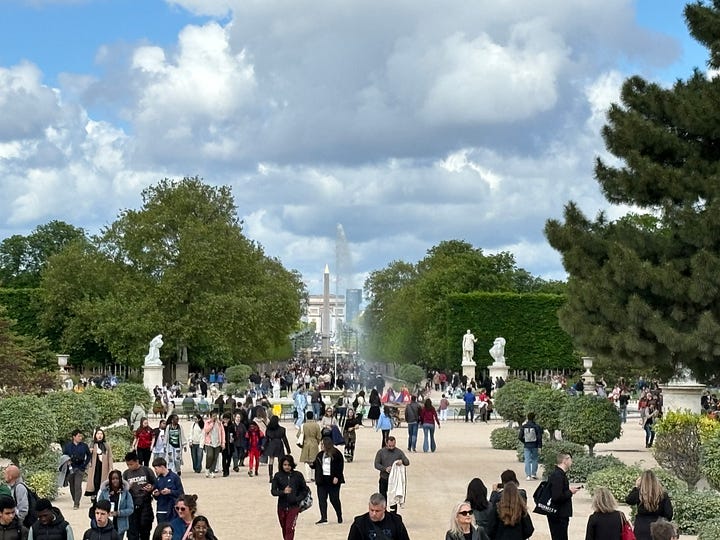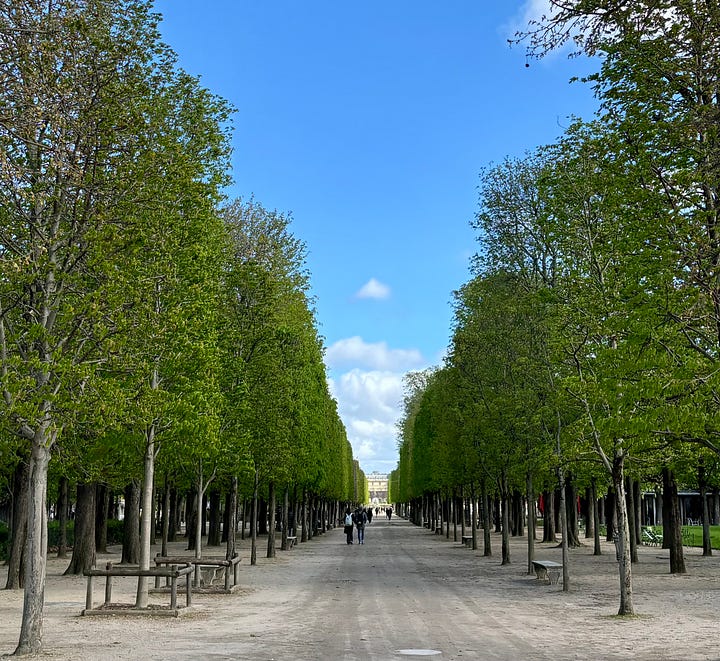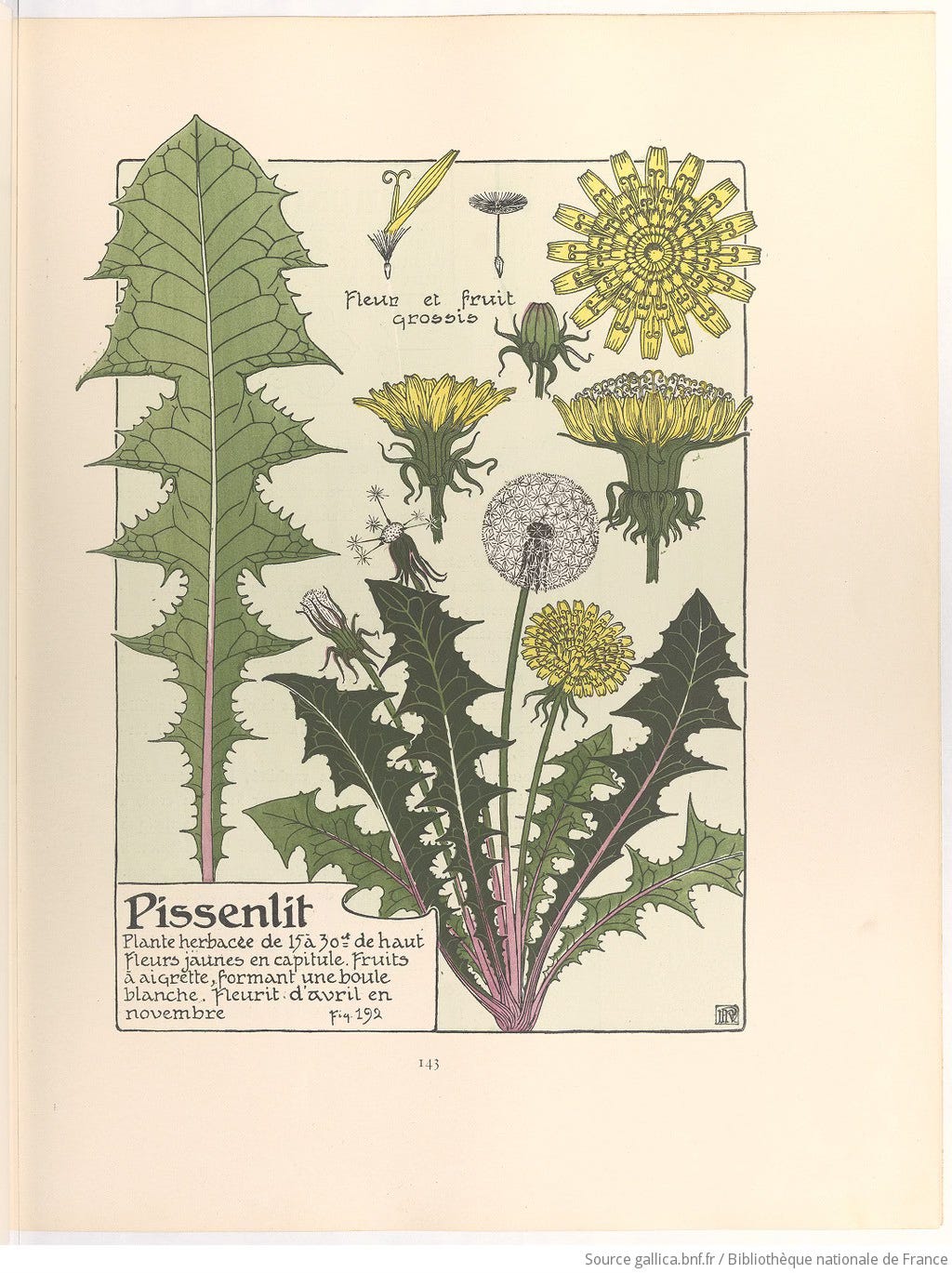Summer is here! It's a good time to check on that 'Jardin Secret' of yours.
A few thoughts on those seedlings (your dreams and ideas), and ideas on how to care for it.
Bonjour Les Amis - welcome back.
If you are like me, you are looking at the calendar and wondering how we have reached June of 2025.
It’s a good chance to stop and reflect. I try to do so every month, but a few days ago, on a morning walk, Paris gave me a stark and beautiful reminder of how important reflections are.

I look back on my year-end ceremony, where I purge the things I want to leave behind and focus on what I want to include in my new year. I cannot help but think of all those wishes and intentions I set.
I managed to accomplish a few things, but my ‘wish list’ of things yet to do seems to get longer and longer.
But the wonderful thing about setting a check-in point is that you can assess your situation thoroughly.
No matter where we are with our goals on June 1st, we know that time keeps moving even if we are not. In three weeks, we will have reached the Solstice d’étè (the official start of summer) on June 21st. And summer usually brings warm weather here in Paris.
I cannot help but think about the typical summer activity: gardening—something we should all be doing, most importantly in our Jardin Secret.
What are you planting in your 'Jardin Secret'?
March is the great month of transformation! This is the month we start seeing signs of the heavily anticipated Le Printemps.
The Jardin Secret is a little plot of sacred land in our brains and/or hearts, where we plant the seeds for those dreams and intentions. Months later, now that we are in the heat of summer, how are those Jardins looking?
I’ll be there first to tell you, living in an apartment in Paris, I don’t often get to try my hand at gardening…nor do I fancy myself as a gardener. If you want to see me look terrified, offer me a plant. My heart will sink knowing that out of the three of us (you, me, and my new plant), one of us probably won’t be around for the next gathering.
I know just as much about gardening as I did sixteen years ago when I started researching running a business in France. But the thrill of not being an expert in something means you can learn something new - what luck! You can approach it from new angles - you can look at it differently. You can enjoy the thrill of childlike curiosity. All of those are benefits in my mind, so let’s keep that spirit the next time we encounter something we don’t feel competent in. We are.
So, as you’d imagine, in the spirit of learning, I dove into the subject of gardening. And guess what? The parallels between maintaining our physical gardens and jardin secret are fascinating.
Yet again, Mother Nature has so much to teach us about growing seeds.
Speaking of seeds (i.e., dreams and ideas)…
Have you ever considered how delicate seeds are - how much it takes for a little seedling to germinate and then fight to grow into a plant? It’s hard work. Seedlings are precious and delicate and need constant care.
More times than I care to admit, I have planted seeds that never peeped through the soil. When that happens, I always try to understand what went wrong. Why do some of those seeds (dreams and ideas) never blossom?
I suspect for a variety of reasons. When I started researching this same question in the context of physical gardens, I found plenty of incredible lessons.
Ideas on why your seeds are not growing (and questions to ask yourself):
They were planted too soon. Timing is everything. A delicate seed planted too early will not bud. Question: Is the timing right?
It wasn’t planted in the right soil or environment. Environments are everything. Question: Am I in the right place, at the right time, with the right people?
It didn’t have enough distance between seeds. Cluttered seeds fight for energy, attention, and resources. Question: Have you considered how many you can plant and really care for?
You planted the seeds too deep: There is an optimal distance the seedling should travel to reach the top of the soil. Question: Do you really want that seed to come to life, or do you need it for escapism and daydreaming? FYI - we all have those types of seedlings, and that is perfectly normal!
Other seeds are stronger and consume all the nutrients; only the strongest will survive. Planting multiple seeds is also betting against the odds—the fit ones will make it. Question: If you planted multiple seeds, are you conscious of which is growing faster than usual? You cannot be everywhere at once - are you prepared to prune away the seeds that aren’t going to be fruitful? It is better to have one strong seed than a handful of failing ones.
It’s just not meant to be. Sometimes, seeds are just never going to germinate. There are no answers - chalk it up to a law of nature; not every seed is meant to turn into a whole plant. But in the same spirit of nature, perhaps when that seed returns to the soil, it fertilizes another. Question: When you see something just won’t work, how do you respond? Can you move on, refocus, and use that undeveloped seed as a source of information and learning?
Lastly, one of my favorites: The land wasn’t prepared to receive the seeds. One of the big activities in preparing a garden is cleaning and tilling* the soil (i.e., your mind.) Question: Were you mentally ready to care for and grow your seeds, i.e., your dreams and ideas?
*According to several gardening websites, tilling is crucial. It prepares the soil to permit moisture and air to permeate, allowing seeds to germinate. It also encourages root growth so they are anchored. For different reasons, some fields may need to be tilled multiple times before planting (I’ll put my brain in this category!).
And size doesn’t matter. It’s the health of the soil. Even the most petit jardin needs to be prepared to be successful.
Speaking of Petit Jardin…
If you didn’t realize, Parisians love a bit of nature. Within the city of Paris, we have over 400 green spaces - some larger than others, but even the tiny ones count! Even in those tiny plots of land, something magnificent can grow.
Seven of our great Jardins are managed by the l’Etat (The State is often called the French Government). You’ll undoubtedly know the ones on this list, and I suspect you have visited a few of them. They are: les Jardins des Tuileries and du Louvre, le Jardin du Palais-Royal, le Jardin des Plantes, le Jardin du Luxembourg, le Parc de la Villette and le Jardin d'Acclimatation.


You only need to take a quick stroll through these magnificent jardins to see that they are cared for rigorously. Everything you love, from the rows of roses to the beautiful box-shaped trees, is thanks to constant care and trimming…including getting rid of those mauvaise herbs…
(FYI, you’ll notice that Jardins in Paris are for aesthetic pleasure. Double-check before you sit on the grass. Many times, it is interdit (forbidden!).)
Speaking of Mauvaise Herbs…
Mauvaise Herbs are ‘weeds’ in French.
I had a particular opinion about weeds until I saw a beautiful post from
. In her most recent newsletter, she had a byline that I loved. She wrote, ‘Even the Weeds are Sweet.’ And you know what? That got me thinking.Yes they can be.
Did you know that Le Pissenlit (Dandelion), which many consider a weed, is used in French cuisine? It is the base for soups and herbal teas and is said to have many health benefits.
The moral of the story is - don’t judge a weed (or book) by its cover. Before you do, make sure you take time to study it. Consider its role, its actual value, not the value you think it should have.
Often, we find ourselves disappointed because we expect something or someone to be something they are not. A Pissenlit will never be used to make fragrance, but it can do many other wonderful things.
I hope I may have prompted you to think differently about pissenlits , but whatever you put in your garden, think twice about navettes (turnips).
A little bit of French 'l’argot’ (slang) for you. If you call someone or something a Navet (Turnip) in France, you are saying that it lacks value, it’s imbecilic, boring, etc. And let’s face it, hings that are boring and lack value don’t fill you with enthusiasm to care for them.
Speaking of caring…
Here are my tips for caring for your Jardin Secret:
Surround yourself with an innovative and supportive community: No navets (turnips) allowed! Your environment (including those in it) is crucial.
Take responsibility: Your jardin is yours to maintain. Be honest about where it is compared to where you want it to be. You can only create a plan when you are clear on where you are going.
Establish rituals: Rituals are so helpful. They set the tone. They tell your brain that something special is about to happen. Find ways to create a little ceremony to begin your gardening practice. We know that a busy and overcrowded mind is not a great place for planting, so when you are ready to start thinking about those dreams and ideas and how you want to grow them, put yourself in the right frame of mind. When starting on a new project, one of my rituals is to go to the library to outline what it will look like.
Constantly check your soil, i.e., your mind: Don’t forget the importance of tilling the soil and keeping it fresh. Why not try morning journaling, meditating, reading, listening to soothing music, making your favorite cup of tea, or going on a morning walk. I try to practice all of these.
Think carefully about who you invite into your Jardin: Make sure they are trustworthy, have your best interest at heart, and are kind. I read a piece in Shane Parrish’s book “Clear Thinking," and it really stuck with me. He explained the difference between Nice Friends and Kind Friends. Kind friends will tell you the hard truth; Nice friends will avoid a difficult conversation. Kind friends will tell you that your jardin looks a little dry and abandoned, reminding you to care for it. If they are really kind, they might just help you water it.
Shine a light on your growing seedlings: Nothing good grows in darkness. While your Jardin Secret is a beautiful little germination box, at some point, you must bring those little dreams into the light of day! We all know there is no perfect time. But, the worst time is: Never. If you want them to survive and continue to grow stronger, you’ll need to take the risk.
Find joy in exploring your jardin: If you keep at it, every day you will find a new development, even the tiniest one. And just the mere fact of working on something so precious, like your little seedlings, will make you happy.
Speaking of Happiness….
It’s a theme you’ve seen me touch on again and again. All of our pursuits should lead us to some form of happiness, even if they are the little pursuits of cultivating our Jardin Secret.
Bon jardinage, mes amis. Make a beautiful one, even if it is tiny.
Until next time, a prompt I’ll leave you with:
What do you need to make sure your Jardin Secret thrives?
See you next time. Á bientôt, mes amis.
Jane
A few last things:
If you want to work on your Jardin here in Paris, join me:
My GenerateHER retreats are live! I am so excited to host the next sessions this autumn!
If you want to see my view of life in Paris, join me on my podcast:
I publish an episode each week. I’d love it if you listened to it and let me know what you think! You can find more here.












I loved this, Jane.
What a great read, you champion for writing such a great prompt. You really are something ✅❤️👍🇦🇺